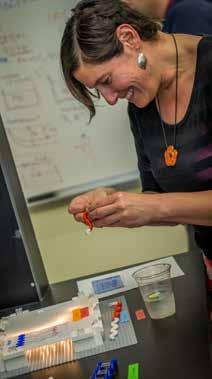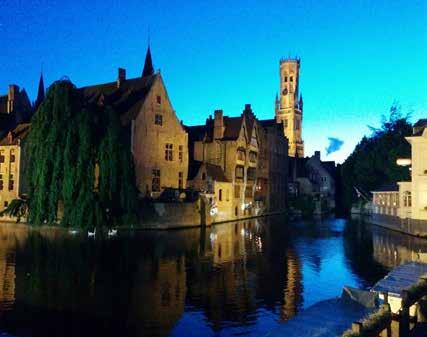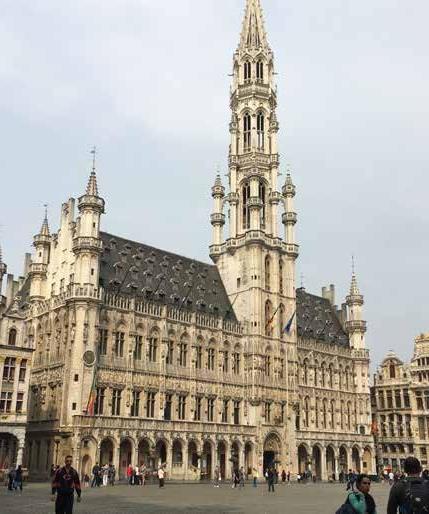
10 minute read
New INBT Leadership
Gerecht and Mao Take Helm of INBT
BY MARY SPIRO
Advertisement
On January 1, 2017, leadership duties for Johns Hopkins Institute for NanoBioTechnology (INBT) passed to professors Sharon Gerecht and Hai-Quan Mao of the Whiting School of Engineering. Gerecht now leads INBT as Director and Mao serves as Associate Director. INBT’s outgoing Director, Peter Searson of the Department of Materials Science and Engineering, and Associate Director, Denis Wirtz, the University’s Vice Provost for Research and Theophilus H. Smoot Professor in the Department of Chemical and Biomolecular Engineering, step down after 10 years; both remain at Hopkins.
“Sharon and Hai-Quan embrace INBT’s original vision, which seeks to bring together researchers from diverse disciplines to solve problems at the interface of nanotechnology and medicine,” said INBT’s founding director Peter Searson and Joseph R. and Lynn P. Reynolds Professor. “Their contributions to multidisciplinary research, commitment to technology transfer, and vision in educating the next generation of leaders in nanobiotechnology made Sharon and Hai-Quan ideal candidates for the job. Denis and I were delighted to pass the baton to two outstanding faculty members who both have a remarkable track record of innovation and translation.”
Gerecht, the Kent Gordon Croft Investment Faculty Scholar, is a professor in the Department of Chemical and Biomolecular Engineering. Her research focuses on ways to control the fate of stem cells, which are the most fundamental building blocks of tissues and organs. She was the inaugural winner of the University President’s Frontier Award.
Mao is a professor in the departments of Materials Science and Engineering and Biomedical Engineering, and currently holds a joint appointment in the Translational Tissue Engineering Center at Johns Hopkins School of Medicine. His research is focused on engineering novel nano-structured materials for nerve regeneration and therapeutic delivery. He won the University’s 2015 Cohen Translational Engineering Award and a 2015 University Discovery Award.
“Since its inception, INBT has been a leader in cross-divisional research at Johns Hopkins. Under Sharon and Hai-Quan’s leadership will further the institute’s mission to advance research and education at the intersection of engineering, medicine, and health.” said Whiting School dean Ed Schlesinger.



Ten Years and Counting
BY MARY SPIRO
On April 21, 2016, Johns Hopkins Institute for NanoBioTechnology hosted an open house to celebrate its tenth anniversary as a research entity. More than 100 people gathered in Croft Hall to share memories and try one of 15 hands-on demonstrations developed by the labs located in the building.
INBT was officially launched May 15, 2006, with $4 million in funding from Senator Barbara Mikulski under then university president William H. Brody.
“At that time, Denis (Wirtz) and I anticipated that there would be new opportunities for physical scientists and engineers to collaborate with biomedical researchers and clinicians in solving problems in medicine, specifically problems at the molecular and nanoscale,” said founding director Peter Searson. “Since multidisciplinary collaborations across departments and divisions were not prevalent then, the deans of medicine, public health, engineering, and arts and sciences supported the creation of the institute to build the infrastructure to support and promote these efforts.”
Today INBT has 250 affiliated faculty members across all university campuses. A core group of faculty reside in the 26,000 square feet of laboratory space located in Croft Hall on the University’s Homewood campus. Croft Hall serves as a focal point for INBT activities and headquarters for staff, where researchers from eight departments in the Whiting School of Engineering and the Johns Hopkins School of Medicine collaborate under one roof.
“INBT has catalyzed multidisciplinary research across the university,” said Landon King, executive vice dean of the Johns Hopkins School of Medicine. “The collaborations between engineers, scientists, and clinicians initiated by INBT have led to numerous discoveries, partnerships, and new companies.”
Over the last decade, INBT researchers have generated more than $80 million in research funding. The institute manages a diverse portfolio of research projects and has established numerous research centers and initiatives, such as the Physical Sciences-Oncology Center, Center for Cancer Nanotechnology Excellence, Center for Digital Pathology, and the Blood-Brain Barrier working group.
An award from the Howard Hughes Medical Institute in 2006 helped create the NanoBio training program. With funding from the National Institutes of Health and the National Science Foundation, 89 PhDs have been awarded to students from eight departments in the Whiting School of Engineering and the Krieger School of Arts and Sciences. INBT also supports a postdoctoral training program.
INBT is home to an NSF Research Experience for Undergraduates (REU) that has supported 104 students over eight years, and receives more than 700 applicants for 10 internships each year. INBT hosts an International Research Experience for Students (IRES) program, providing internships to work at IMEC, a world-class nano-fabrication facility in Leuven, Belgium.
Thanks to those who celebrated with us that day and to those who continue to support the work of INBT every day. Photos provided by INBT staffer Jon French.
Engineers Unravel Complexities of Cancer
BY MARY SPIRO
Artist's image of a cancer cell traveling through a 3D matrix that closely resembles the environment through which cancer cells move in a human body.

Engineers and clinicians are working together to reveal the mysteries of cancer through the newly funded Johns Hopkins Physical Sciences-Oncology Center (PS-OC), launched via a $9 million federal grant to the Institute for NanoBioTechnology. The Johns Hopkins PS-OC is the second time that the National Cancer Institute has chosen to fund INBT to create an entity through which physical scientists, cancer biologists, clinicians and other researchers can collaborate to help solve the challenges of diagnosing and treating cancer. INBT’s first PS-OC was funded from 2009 to 2014.

The Hopkins PS-OC will be part of NCI’s Physical Sciences Oncology Network, a collective of 10 centers at research institutions nationwide. INBT’s center will engage researchers from the Johns Hopkins School of Medicine and the Whiting School of Engineering, as well as collaborators from Washington University in St. Louis, the University of Pennsylvania and the University of Arizona.
The research goals of this new PS-OC incarnation will build upon the foundations of the center’s first iteration and delve into discovering the mechanism of metastasis – or how cancer cells break free from a primary tumor to seed tumors in distant organs.
Denis Wirtz, Johns Hopkins Vice Provost for Research, directs the new center as he did the first PS-OC. Wirtz is also the T. H. Smoot professor in the Department of Chemical and Biomolecular Engineering and a member of the Johns Hopkins Kimmel Cancer Center.
Instead of looking at other aspects like tumor growth, I’ll be working with my colleagues in the schools of engineering and medicine to uncover the physical underpinnings of cancer metastasis The ‘team science’ approach in our center should result in the creation of new therapies targeting metastasis, the primary cause of human cancer deaths.
“Instead of looking at other aspects like tumor growth, I’ll be working with my colleagues in the schools of engineering and medicine to uncover the physical underpinnings of cancer metastasis,” Wirtz said. “The ‘team science’ approach in our center should result in the creation of new therapies targeting metastasis, the primary cause of human cancer deaths.”
Kenneth Pienta, a professor of urology, oncology, and pharmacology and molecular sciences at the Johns Hopkins University School of Medicine and also a member of the Kimmel Cancer Center, will be the PS-OC’s associate director. Currently, Pienta’s research involves studying tumor microenvironments and how they contribute to the formation of tumors and metastasis. His bench laboratory program focuses on the development of new therapies for prostate cancer.
Johns Hopkins Physical Sciences-Oncology Center has three primary research areas: • The Role of Physical Cues in Collective Cell Invasion – This project examines how the physical forces exerted upon cancer cells when they are confined within a tumor can affect the migration of these cells, both collectively and individually. The team is led by Konstantinos Konstantopoulos, professor and chair of Department of Chemical and Biomolecular Engineering. • Forces Involved in Collective Cell Migration – When they break away from a tumor, some cancer cells seem to prefer to travel in groups. This team, led by Wirtz, studies the forces involved in organizing the collective migration of breast cancer cells in both 2D and 3D environments. • Impact of low oxygen on the migration of sarcoma cells – Low oxygen within a tumor (hypoxia) dramatically increases pulmonary metastasis and results in poor health outcomes. Research led by Sharon Gerecht, a professor of chemical and biomolecular engineering, investigates how primary tumor cells respond to oxygen in their microenvironment. The goal is to better understand the spread of cancer and identify new treatment targets.
Other members of the Johns Hopkins PS-OC center include Andrew Ewald and Daniele Gilkes of the School of Medicine, PeiHsun Wu and Sean X. Sun of the Whiting School of Engineering, Karin Eisinger and Celeste Simon of the University of Pennsylvania, and Charles Wolgemuth of the University of Arizona.

From left: Lydia Carroll, Stephanie Cai, Lakyn Mayo, and Chris Argento on top of Gravensteen Castle in Ghent. Not pictured, Michael Signorelli.
Research Vacation is All They Ever Wanted
BY MARY SPIRO
Every summer since 2009, undergraduate students have had the chance to spend 10 weeks conducting research at a world-class microfabrication research facility known as IMEC in Leuven, Belgium. Founded and administered by Johns Hopkins Institute for NanoBioTechnology (INBT), a select group of University students experience intense research opportunities in an international environment.
INBT’s International Research Experience for Students (IRES), funded by the National Science Foundation, has grown in popularity among the Johns Hopkins students who compete for a handful of available research positions. During the summer of 2016, INBT was able to send five students to Belgium, the largest group ever. The 2016 students chosen included undergraduates Stephanie Cai, Lydia Carroll and Michael Signorelli from biomedical engineering; Lakyn Mayo from materials science and engineering; and master’s degree student Chris Argento from chemical and biomolecular engineering.
Argento helped with the development of a droplet microfluidic system to screen the fermentation characteristics of yeast strains used in manufacturing everything from beer to biofuels.
“The system shrinks this process from a flask down into tiny microdroplets on a silicon chip, meaning it could potentially screen


thousands of strains rapidly and at lower cost,” Argento said. “This experience familiarized me with both microdroplets and cell culture, as well as the many other ways that IMEC applies nanotechnology to the life sciences. I gained an interest in how microfluidics and nanoscience as a whole can be utilized to improve health.”
In addition to technical skills, students reported intangible benefits from the program.
“This summer opened my eyes to the diversity of work I could do after graduation,” said Cai. Her project focused on optimizing ultra-fast quantitative PCR on-a-chip and resolving challenges related to DNA fragment amplification that arise when qPCR is performed rapidly. “While I truly value the research and laboratory skills I learned, one of the biggest takeaways is that academia and industry can exist symbiotically, and there are companies out there that foster this kind of collaboration.”
Not all projects involved lab-on-chip devices. Carroll worked on processing electroencephalography (EEG) signals from a new type of headset that can be used outside the lab. “This research exposed me to advanced signal processing and machine learning, both of which are very applicable to my future work as an engineer,” Carroll said. “I also got the chance to practice planning and running my own project, which is something I'll be expected to do as soon as I graduate.”
Of course, no trip to Belgium would be complete without sampling the country’s famous beer, chocolate and waffles. Participants also had a chance to explore nearby European cities, such as Paris and London.
“My time at IMEC through INBT gave me a new perspective on biomedical engineering and the options available for microelectronics,” concluded Carroll. “I had a great time at IMEC this summer and learned a lot about academic research as a whole.”
The students wrote about their experiences both in and out of the lab via blog posts on the website “INBT’s summer at IMEC Research Program.” For a more complete picture of the life of an INBT summer international research intern, go to http://inbtsummer-at-imec.blogspot.com.
Top: Bruges at night. Photo by Chris Argento Bottom: At the Grote Markt in Leuven. Photo by Michael Signorelli

